Neman
The Nemunas, Nioman, Neman, Nyoman, Niemen or Memel,[nb 1] is a major Eastern European river. It rises in Belarus and flows through Lithuania before draining into the Curonian Lagoon, and then into the Baltic Sea at Rusnė Island. It begins at the confluence of two smaller tributaries about 15 kilometers (9 mi) southwest of the town of Uzda in central Belarus, and about 55 km (34 mi) southwest of Minsk. In its lower reaches it forms the border between Lithuania and Russia's Kaliningrad Oblast. It also, very briefly, forms a part of the Belarus–Lithuania border. The largest river in Lithuania, and the third-largest in Belarus, the Neman is navigable for most of its 900 km (560 mi) length.
| Nemunas | |
|---|---|
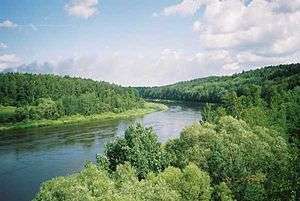 The Nemunas near Alytus | |
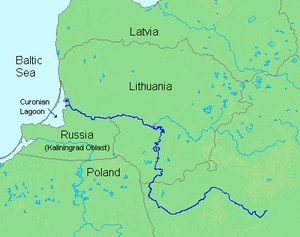 Map highlighting Neman | |
| Native name | Nemunas |
| Location | |
| Country | Belarus, Lithuania, Russia |
| Cities | Hrodna, Kaunas, Sovetsk |
| Physical characteristics | |
| Source | |
| • location | Southwest of Minsk, Belarus |
| • coordinates | 53°15′10″N 27°18′21″E |
| • elevation | 176 m (577 ft) |
| Mouth | Curonian Lagoon |
• location | West of Šilutė, Lithuania |
• coordinates | 55°20′12″N 21°14′50″E |
• elevation | 0 m (0 ft) |
| Length | 914 km (568 mi) |
| Basin size | 98,200 km2 (37,900 sq mi) |
The Neman/Nemunas river basin formed during the Quaternary period, and is located roughly along the edge of the last glacial sheet, dating from about 25,000 to 22,000 years BC. Its depth varies from 1 meter (3 ft 3 in) in its upper courses to 5 meters (16 ft) in the lower basin.
Numbers
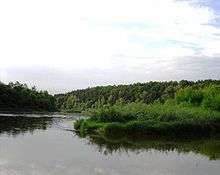
- The total length of the Nioman/Nemunas/Neman is 914 km (568 mi).[1] It is the 4th longest river in the Baltic Sea basin. Over its entire length, 436 km (271 mi) flows in Belarus[1] and 359 km (223 mi) in Lithuania. A 116 km (72 mi) stretch is the border between Lithuania and Russia's Kaliningrad oblast.
- Its greatest depth is 5 m (16 ft), and at its widest it extends about 500 m (1,600 ft).
- The Nioman/Nemunas/Neman is a slow river; it flows at about 1 to 2 m/s (3.3 to 6.6 ft/s).
- During floods, water discharge can increase up to 11-fold, to more than 6,800 m3/s (240,000 cu ft/s). Severe floods occur on the lower reaches of the river about every 12 – 15 years, which sometimes wash out bridges.[2]
- The Nioman/Nemunas/Neman is an old river, dating back to the last glacial period. Its valley is now up to 60 meters (200 ft) deep and 5 km (3 mi) broad.
- It has about 105 first-class tributaries, the largest being the rivers Neris (Viliya) (510 km (320 mi)), Shchara (325 km (202 mi)), and Šešupė (298 km (185 mi)). Fifteen of the tributaries are longer than 100 km (62 mi).
- In the complete Nioman/Nemunas/Neman basin, there are tributaries extending to the 11th order.
- The Nemunas basin in Lithuania drains more than 20,000 rivers and rivulets and covers 72% of Lithuania's territory.
- The total area of the Nioman/Nemunas/Neman basin is 98,200 km2 (37,900 sq mi),[1] 34,610 km2 (13,360 sq mi) of which are within Belarus,[1] the Lithuanian portion of this basin is 46,695 km2 (268 sq mi).
- Valley of Nioman in Hrodna Region is the lowest point above sea level in Belarus at 80 to 90 m (260 to 300 ft).[3]
River course
Nemunas loops
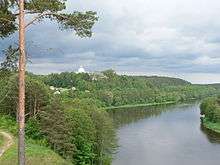
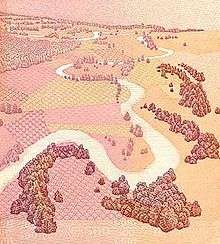
Since the loops are located in Lithuania, they are often referred to as "The Nemunas loops".
In 1992 Nemunas Loops Regional Park was founded. Its goal is to preserve the loops (Lithuanian: vingis) that the Nemunas makes in the Punia forest. Near Prienai, the Nemunas makes a 17-kilometer-long (11 mi) loop (like a teardrop) coming within 1.2 km (3⁄4 mi) of completing the loop. The Nemunas flows along the double bend between Balbieriškis and Birštonas for 48 km (30 mi) and then moves in a northerly direction for only 4.5 km (2 3⁄4 mi). The loops are not conventional river meanders; they follow underlying tectonic structures. The faults are the source of the mineral springs in the area.[4] The area is historically and culturally significant. Its castles served as the first line of defense against forays by the Teutonic knights.
Delta
At its delta the Nemunas splits into a maze of river branches and canals mixing with polders and wetlands and is a very attractive destination for eco-tourism. The four main distributaries are Atmata, Pakalnė, Skirvytė and Gilija. The river plays a crucial part in the ecosystem of the Curonian Lagoon. It provides the main water inflow to the lagoon and keeps the water almost fresh. This allows both fresh water and mixed water animals to survive there. As the river's delta expands, the lagoon shrinks. Since the delta is in Lithuania, it is often referred to as Nemunas Delta. Nemunas Delta Regional Park was created in the delta in 1992.
Tributaries
The following rivers are tributaries to the river Neman/Nemunas (from source to mouth):
Largest settlements on the river
From west to east, the largest settlements are Sovetsk/Tilsit, Neman, Kaunas, Alytus, Druskininkai, Grodno, and Masty.
Significance in culture
Ptolemy referred to Nemunas as Chronos (although competing theories suppose Chronos was in fact Pregolya).
The river has lent its name to the Neman Culture, a Neolithic archaeological subculture.[5]
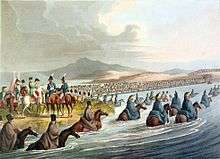
In German, the part of the river flowing in what earlier was Prussia has been called die Memel at least since about 1250, when Teutonic Knights built Memelburg castle and the town of Memel at the mouth of the Curonian Lagoon, naming it after the indigenous name of the river, Memel. The city of Memel, now in Lithuania, is known today as Klaipėda (confusingly, the city of Memel was on the Dange River, now called the Danė River, not the Memel River). On German road maps and in German lexika, only the 112-kilometer (70 mi) section within Prussia (starting at Schmalleningken) was named Memel; the part outside Germany was labelled Niemen.
The border between the State of the Teutonic Order and Lithuania was fixed in 1422 by the Treaty of Lake Melno and remained stable for centuries. The Treaty of Tilsit between Napoleon and Tsar Alexander I was signed on a raft in the river in 1807.[6] Napoleon's crossing at the outset of the 1812 French invasion of Russia is described in War and Peace[7] and also mentioned in Pan Tadeusz. In 1919, the Treaty of Versailles made the river the border separating the Memel Territory from German East Prussia as of 1920. At that time, Germany's Weimar Republic adopted the Deutschlandlied as its official national anthem. In the first stanza of the song, written in 1841, the river is mentioned as the eastern border of a (then politically yet-to-be united) Germany:
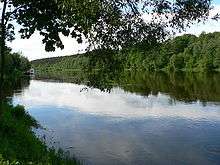
| German lyrics | Approximate English translation |
|---|---|
| Von der Maas bis an die Memel, Von der Etsch bis an den Belt |
From the Meuse to the Memel, From the Adige to the Belt |
Lithuanians refer to the Nemunas as "the father of rivers" (Nemunas is a masculine noun in Lithuania). Countless companies and organizations in Lithuania have "Nemunas" in their name, including a folklore ensemble, a weekly magazine about art and culture, a sanatorium, and numerous guest houses and hotels. Lithuanian and Polish literature often mention the Nemunas. One of the most famous poems by Maironis starts:
| Lithuanian lyrics | Approximate English translation |
|---|---|
| Kur bėga Šešupė, kur Nemunas teka | Where the Šešupė runs, where the Nemunas flows |
| Tai mūsų tėvynė, graži Lietuva | That's our fatherland, beautiful Lithuania |
Almost every Lithuanian can recite these words by heart.
There are many other smaller rivers and rivulets in Lithuania with names that may have been derived from "Nemunas" — Nemunykštis, Nemuniukas, Nemunynas, Nemunėlis, Nemunaitis. The etymology of the name is disputed: some say that "Nemunas" is an old word meaning "a damp place",[8] while others that it is "mute, soundless river" (from nemti, nėmti "to become silent", also memelis, mimelis, mėmė "slow, worthless person").[9] The name is possibly derived from the Finnic word niemi "cape".[10]
Art critics praised its depiction in the paintings by Michał Kulesza.[11][12]
Economic significance
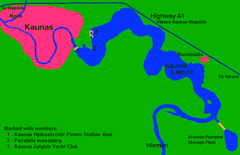
The Nemunas River is used for a variety of purposes such as fishing, hydropower generation, water supply, industry, and agriculture, as well as recreation, tourism, and water transport. There have been proposals to deepen its watercourse below Kaunas to make it more consistently usable.[13]
The largest cities on the river are Grodno in Belarus, Alytus and Kaunas in Lithuania, and Sovetsk in the Kaliningrad Oblast of Russia. The river basin has a population of 5.4 million inhabitants. Industrial activities in the Belarusian section include metal processing, chemical industries, pulp and paper production, and manufacturing of building materials, as well as food-processing plants. In Lithuania, the city of Kaunas, with about 400,000 inhabitants, is the country's principal user of the river; the local industries that impact the river are hydropower generation, machinery, chemical, wood processing and paper production, furniture production, textile and food-processing. In Kaliningrad, industrial centers near the river include Sovetsk and Neman, which have large pulp and paper production facilities.
Above Kaunas a dam was built in 1959 to serve the Kaunas Hydroelectric Power Plant. The resulting Kaunas Reservoir (Lithuanian: Kauno marios) is the largest such lake in Lithuania. It occupies 63.5 km2 (24 1⁄2 sq mi); its length is 93 km (58 mi); its greatest depth is 22 m (72 ft). The reservoir is a popular destination for Lithuanian yachting.
The Augustów Canal, built in the 19th century, connects the Neman to the Vistula River.
Biological communities
The following fish have been found in the Nemunas/Neman River: perch, pike, zander, roach, tench, bream, rudd, ruffe, and bleak. Its tributaries also contain stone loach, the three-spined stickleback, minnows, trout, sculpins, gudgeon, dace and chub.
Atlantic salmon formerly migrated upstream to spawn; however, dams on the river, most of them built in the 20th century, has reduced their numbers considerably. The dam at Kaunas does not provide fish ladders. The spawning season took place in the fall; ethnographic studies of the time report that night fishing, using torches and harpoons, was a common technique.
Environmental issues
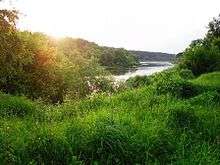
A report by the Swedish EPA (Environmental Protection Administration) rates the quality of the Nemunas in Lithuania as moderately polluted or polluted. High concentrations of organic pollutants, nitrates and phosphates occur in different parts of the river. Environmental issues include water quality (eutrophication and pollutants), changes in the hydrological regime, and flooding control. The environmental problems in each of the countries that make up the basin are slightly different. In Belarus, the main problems are oil products as well as nitrogen and BOD (biological oxygen demand). The environmental issues in the Kaliningrad section include high concentrations of BOD, lignosulphates, and nitrogen. In Lithuania, the operations of the Kaunas Hydroelectric Power Plant cause changes of the water level that affect the riparian ecosystem. Old wastewater treatment facilities along the entire river also contribute to pollution.[14]
The co-operation necessary to ensure the health of the river is complicated by the political divisions in the basin - its territory is shared among Russia, Belarus and the European Union country of Lithuania. Several co-operation initiatives are underway to address the environmental issues of the river.
See also
- List of rivers of Europe
- Normandie-Niemen (a fighter squadron, later regiment (of three squadrons) of the French Air Force)
- Memelland
- East Prussia
Notes
- In the languages of various nations through which the river either flows or formerly flowed or that have distinct names for it: Lithuanian:

References
- "Main Geographic Characteristics of the Republic of Belarus. Main characteristics of the largest rivers of Belarus". Land of Ancestors. Data of the Ministry of Natural Resources and Environmental Protection of the Republic of Belarus. 2011. Archived from the original on 15 January 2014. Retrieved 27 September 2013.
- Floods and fires in Lithuania
- "Main Geographic Characteristics of the Republic of Belarus". Land of Ancestors. The Scientific and Production State Republican Unitary Enterprise “National Cadastre Agency” of the State Property Committee of the Republic of Belarus. 2011. Archived from the original on 21 September 2013. Retrieved 20 September 2013.
- "The Great Nemunas Loops". Nemunas Loops Regional Park. Archived from the original on February 26, 2008. Retrieved 2009-01-10.
- Rimantienė, Rimutė (March 1992). "The Neolithic of the eastern Baltic". Journal of World Prehistory. Springer Netherlands. 6. doi:10.1007/BF00997586.
- "frank-mclynn-napoleon-a-biography-2003 : Free Download, Borrow, and Streaming". Internet Archive. Retrieved 2020-07-23.
- Leo Tolstoy (1915). War and Peace. J.M. Dent. p. 200.
niemen river war and peace.
- Aleksandras Vanagas. Lietuvių hidronimų etimologinis žodynas. 227 psl., – Vilnius: Mokslas, 1981.
- http://www.ve.lt/naujienos/kultura/kultura/memelis-ar-klaipeda-1481368/
- Tadeusz Lehr-Spławiński. O pochodzeniu i praojczyźnie Słowian. – Poznań, 1946.
- Kraszewski, Józef Ignacy (1847). "Pejzaż, Michał Kulesza". Tygodnik Petersburski. 18.
- Gr..., M...; [Michał Grabowski, pseud. of Edward Tarsza] (1849). "5". Projekta Artystyczne w Litwie. Artykuły literackie, krytyczne, artystyczne (Dalszy Ciąg Literatury, Krytyki, Korespondencyi i t.d.). Warsaw: S. Orgelbrand.
- "Transportation initiatives in the Baltic states". Archived from the original on 2006-09-25. Retrieved 2006-12-02.
- Report on the Neman basin issued by the Swedish EPA Archived February 18, 2006, at the Wayback Machine
External links
| Wikimedia Commons has media related to Neman. |
- (in Polish) Niemen (the Neman) in the Geographical Dictionary of the Kingdom of Poland (1886)
- (in English) Glaciation in Lithuania
- (in English) Biotopes in the Neman and its tributaries
- (in English) Atlantic salmon in the Neman River
- Agata Lewandowski, Łosośna - the Unknown Valley. Not the Last Arrival for…Puciłki, „Znad Wilii”, nr 3(79) z 2019 r., p. 58-64, (in Polish)http://www.znadwiliiwilno.lt/wp-content/uploads/2019/10/Znad-Wilii-3-79m-1.pdf
- Helena i Leonard Drożdżewiczowie, Antologia Doliny Łosośny, (in Polish)http://193.0.118.54/search/query?term_1=Antologia+Doliny+%C5%81oso%C5%9Bny&theme=nukat